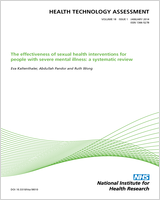Included under terms of UK Non-commercial Government License.
NCBI Bookshelf. A service of the National Library of Medicine, National Institutes of Health.
Clarke CE, Patel S, Ives N, et al.; on behalf of the PD REHAB Collaborative Group. Clinical effectiveness and cost-effectiveness of physiotherapy and occupational therapy versus no therapy in mild to moderate Parkinson’s disease: a large pragmatic randomised controlled trial (PD REHAB). Southampton (UK): NIHR Journals Library; 2016 Aug. (Health Technology Assessment, No. 20.63.)

Clinical effectiveness and cost-effectiveness of physiotherapy and occupational therapy versus no therapy in mild to moderate Parkinson’s disease: a large pragmatic randomised controlled trial (PD REHAB).
Show detailsSTEP 1. Diagnosis of Parkinsonian syndrome
Bradykinesia (slowness of initiation of voluntary movement with progressive reduction in speed and amplitude of repetitive actions).
And at least one of the following:
- muscular rigidity
- 4–6 Hz rest tremor
- postural instability not caused by primary visual, vestibular, cerebellar or proprioceptive dysfunction.
STEP 2. Exclusion criteria for Parkinson’s disease
History of repeated strokes with stepwise progression of Parkinsonian features.
History of repeated head injury.
History of definite encephalitis.
Oculogyric crises.
Neuroleptic treatment at onset of symptoms.
More than one affected relative.
Sustained remission.
Strictly unilateral features after three years.
Supranuclear gaze palsy.
Cerebellar signs.
Early severe autonomic involvement.
Early severe dementia with disturbances of memory, language and praxis.
Babinski sign.
Presence of a cerebral tumour or communicating hydrocephalus on CT scan.
Negative response to large doses of levodopa (if malabsorption excluded).
MPTP exposure.
STEP 3. Supportive prospective positive criteria for Parkinson’s disease. Three or more required for diagnosis of definite Parkinson’s disease
Unilateral onset.
Rest tremor present.
Progressive disorder.
Persistent asymmetry affecting the side of onset most.
Excellent response (70–100%) to levodopa.
Severe levodopa-induced chorea.
Levodopa response for 5 years or more.
Clinical course of 10 years or more.
MPTP, 1-methyl-4-phenyl-1,2,3,6-tetrahydropyridine.
Reproduced from The relevance of the Lewy body to the pathogenesis of idiopathic Parkinson’s disease. Gibb WRG, Lees AJ. 51, 745–52, 1988 with permission from BMJ Publishing Group Ltd.
- UK Parkinson’s Disease Society Brain Bank Diagnostic Criteria - Clinical effecti...UK Parkinson’s Disease Society Brain Bank Diagnostic Criteria - Clinical effectiveness and cost-effectiveness of physiotherapy and occupational therapy versus no therapy in mild to moderate Parkinson’s disease: a large pragmatic randomised controlled trial (PD REHAB)
Your browsing activity is empty.
Activity recording is turned off.
See more...